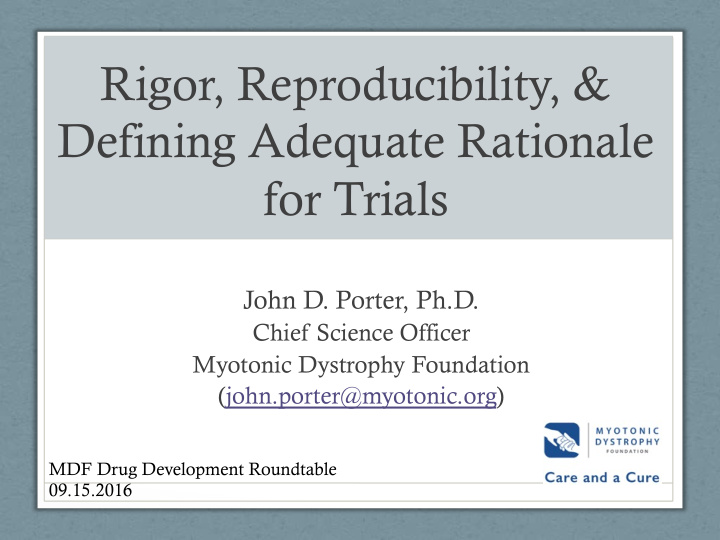



Rigor, Reproducibility, & Defining Adequate Rationale for Trials John D. Porter, Ph.D. Chief Science Officer Myotonic Dystrophy Foundation (john.porter@myotonic.org) MDF Drug Development Roundtable 09.15.2016
Translational Success? Overall success rates of Phase II clinical trials of NCEs fall from 28% to 18% ( Nat Rev Drug Discov 10, 328–29, 2011) How to improve clinical trial success rates for DM?
Reproducibility is a Problem • Bayer validated only 35% of published preclinical studies sampled ( Nat Rev Drug Discov 10: 712, 2011) • Amgen published similar data… • Journal impact factor doesn’t seem to translate into reliability • After 30 candidates, backed by preclinical efficacy data, failed in trials, ALS TDI failed to replicate any of the prior mouse results for 70 different compounds • Matter of design of the preclinical studies • “failure…to demonstrate efficacy…leads us to conclude that the majority of published effects are most likely measurements of noise…” ( Amyotroph Lateral Scler 2008; 9(1):4-15)
Rigor Impacts Effect Size Macleod et al., J Cereb Blood Flow Metab 25: 713-21, 2005 • Meta-analysis of 29 FK506 studies in stroke models • “concerns that estimates of effect size might be too high because of factors such as study quality and publication bias”
Landis et al., Nature 490: 187-91, 2012 Grant applications & publications should report on core parameters of randomization, blinding, sample-size estimation, & data handling; better reporting of studies will lead to rigorous study design NINDS’ emphasis was on Reporting
NINDS Rigor Guidelines • Experimental Design • Rationale for the selected models & endpoints; adequacy of the controls; route & timing of delivery/dosing; powering; stats methodology • Minimizing Bias • Methods of blinding; randomization and/or stratification; reporting of missing data; reporting all results • Results • Independent validation/replication; dose-response; robustness & reproducibility; validation of target engagement/modulation • Interpretation of Results • Alternative interpretations; validation from other literature; size of effect re expected clinical impact; potential COIs
New NIH Rigor Requirements As of 1/25/2016—all NIH applications must address: 1. the scientific premise forming the basis of the proposed research; 2. rigorous experimental design for robust and unbiased results; 3. consideration of relevant biological variables; and 4. authentication of key biological and/or chemical resources.
A 3-Stage Model for Preclinical Efficacy Studies 1. Pilot Study (discovery focus) • Initial testing of cmpd/biologic • But, recognize these studies can carry unintentional biases 2. Exploratory Preclinical Study (mechanism/target focus)* • Efficacy via multiple outcomes 3. Preclinical Trial (cmpd/biologic focus)* • Efficacy via predetermined primary outcome, multiple models/large models when possible *Credit: Howard • Gold standard Fillit * randomized, blinded, clinically relevant design ADDF
Desperately Seeking Scientific Premise Challenge : Boost clinical trial success rate Means to an End : Unbiased examination of all aspects of the rationale / scientific premise behind each clinical trial (basic biology to supporting clinical data)
Therapeutic Pipeline: Stage- Specific Activities FDA FDA IND NDA or BLA Basic Basic/ Preclinical Clinical Research Mechanistic Development Studies & Trials assays & models; trial readiness discover learn how evaluate targets (registries, natural relevant gene/mRNA/ & candidate history, endpoints, gene/mRNA/ protein therapies for safety biomarkers, care protein causes NMD; & efficacy in cells & standards, etc.); run & what it ID drug targets animal models safety/efficacy trials does -
Seeking Scientific Premise: Starting with the Basic Science Basic Basic/ Mechanistic Research Target ID? Is there a basic understanding of the biology of the involved gene, RNA, &/or protein? Do we truly understand the disease mechanism? Or is a non-disease-mitigating/ancillary event being addressed?
Seeking Scientific Premise: Non-Clinical Triaging FDA IND Preclinical Development Optimization? Efficacy; is preclinical POC established? Rigor? Appropriateness of endpoints? Delivery route appropriate? Bioavailability, exposure, PD/PK? Non-clinical program—tox liabilities? Kill early attitude!
Seeking Scientific Premise: Clinical Premise Validation FDA NDA or BLA Clinical Studies & Trials Natural history sufficient—modifiable endpoints in place & variability understood? Risk/benefit assessments? Biomarkers? Early PK/PD assessments? POC at early stage? Prior experience with drug / pathway in pts? Kill early attitude!
Keeping the DM Pipeline Sludge- Free FDA FDA IND NDA & BLA Basic Basic/ Preclinical Clinical Research Mechanistic Development Studies & Trials premise; trial readiness; no ‘translation truly understand basic equipoise; CDEs: early before it’s time;’ mechanisms; funding, hard data decisions: rigor & rationale; recruiting/retaining stage-appropriate clear go/no-go’s talent, & ‘facilitated’ luck conclusions partnering • Optimizing the pipeline: academic—advocacy— Federal funder—drug developer partnering…
Path to Informed Trials Goal: collectively obtain adequate scientific rationale to launch clinical trials & improve on generally poor success rates of those trials Adequate = conducted using best practices to be sufficiently rigorous and well informed Improving how we make unbiased decisions via robust preclinical & clinical evaluation systems
Recommend
More recommend